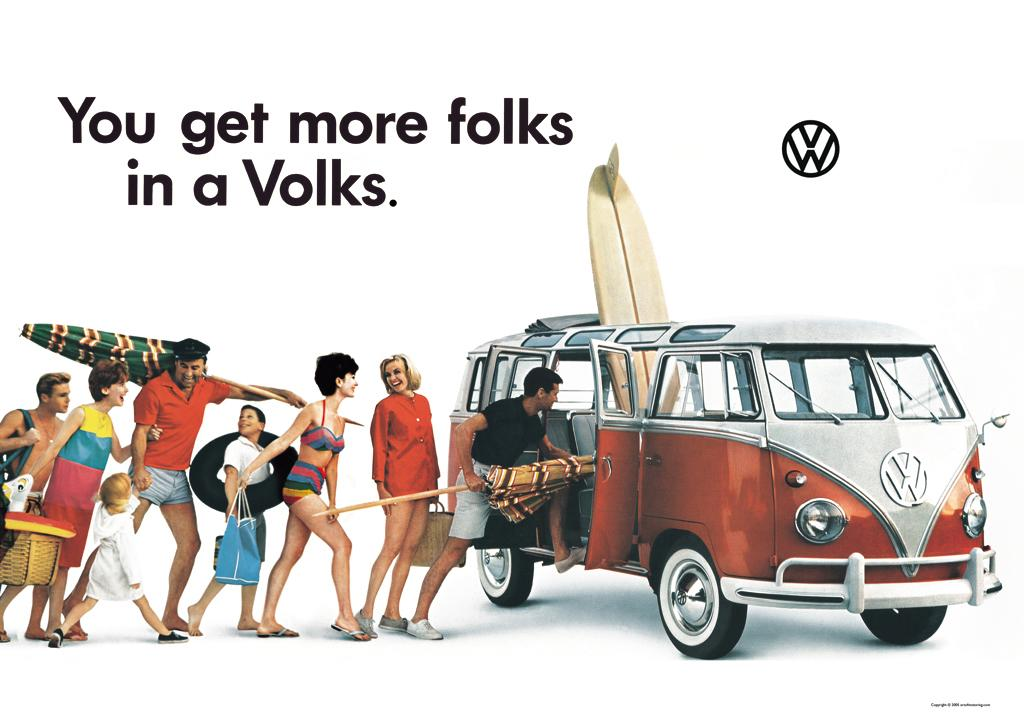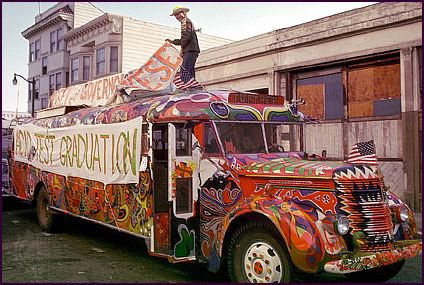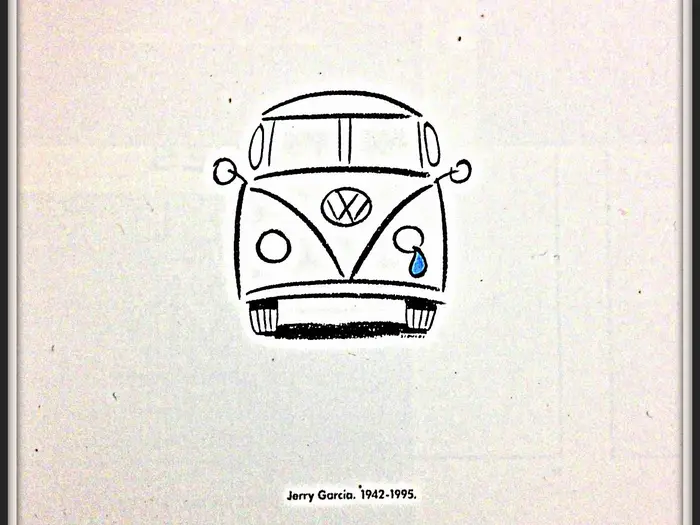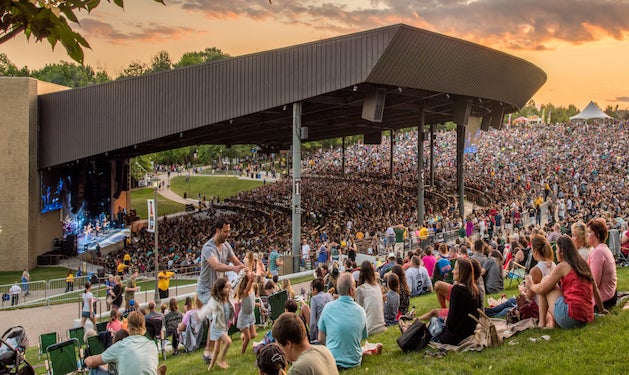Driving the Counterculture: Buses, Vans, and Beetles
Spring Oral History Intern Carlene Bermann explores the use of Volkswagens during everyone's favorite festival and beyond.
- Well we shot the line / And we went for broke / With a thousand screamin’ trucks / And eleven long-haired Friends of Jesus / In a Chartreuse microbus - From Gilberto Gil’s “Volkswagen Blues”
- We took a half a ton of garbage, put it in the / back of a red VW Microbus, took shovels / and rakes and implements of destruction / and headed on toward the city dump. - From Arlo Guthrie’s “Alice’s Restaurant”
- Let me present to you / My Volks-Volkswagen blues / Ready to carry me away / A long way to reach the moon - From C.W. McCall’s “Convoy”
When you think of the traffic jams clogging the roads around Bethel, NY in August of 1969, you probably have a few distinct vehicles in mind; including the wildly painted buses and personal cars that came to symbolize freedom, mobility, and self-expression for a generation of young people looking to break with tradition.
Along with repurposed commercial buses and vans, Volkswagens hit the scene in a big way. The Volkswagen in its varied forms was so endemic to the 1960s that it permeated all visual and aural culture forms. If you were heading to the Woodstock Music & Art Fair in 1969, the most fashionable way to go was with a group of friends in a personalized VW bus. In fact, based on data collected from the Museum’s Alumni Registry, the most popular make of vehicle taken to Woodstock was VW.
Way before the Aquarian Exposition, back in 1950, the Type 2 Volkswagen was introduced. Designed by Dutch businessman Ben Pom as a functional and inexpensive box to move goods from place to place, it came to be called the “Transporter” or “microbus.” Envisioned as a practical vehicle, its creators never anticipated the cultural revolution that turned it into the iconic hippie bus by the end of the 1960s.1

For those groups in need of even more space, the repurposed school bus was the way to go. Similar to today in which a new generation of nomads convert school buses into tiny homes, the bus allowed a new level of freedom to hippies looking to explore and spread the word about their new way of living.
In 1964, One Flew Over the Cuckoo’s Nest author Ken Kesey and his Band of Merry Pranksters immortalized the LSD road trip in their 1939 Harvester school bus named “Furthur.” The bus traveled from Eugene, Oregon to New York City, inspiring other like-minded individuals wherever it stopped. The trend caught on, and other communal groups procured their own buses. In 1969 along with the Pranksters in Furthur, the Hog Farm, the Ohayo Mountain Family, and other communes made their way to gatherings around the country (including Woodstock), in their decked out buses. There was even a Great Bus Race during the summer solstice in Colorado, with many people and vehicles from these groups involved. In 2021 Tony Merlino, a former member of the Long Island Drug Division commune said “When we bought our used bus it had Long Island Drug Division printed on the side, so we just left it that way. Boy did we turn heads when we rolled into a town… we participated in the first annual ‘Great Bus Race’ along with Hugh Romney and the Hog Farm, Ken Kesey… and some of the Pranksters who came in a repaired ‘Furthur,’ and there were others. It was a spectacle for sure, all those vehicles racing at full speed around in the grassy meadow.”

Inspired by these groups, rock bands like The Grateful Dead (who had at the beginning of their career been the house band for the Pranksters) began touring in VW vans painted with flowers and peace signs. These tours had such an impact on the sales of VW vans, that when Jerry Garcia died in 1995, Volkwagen ran an advertisement of a simple black and white microbus with a blue teardrop.2

The VW microbus soon became the choice mode of transport for young people heading to concerts or protest marches due to its ability to fit lots of gear, people, and supplies. It was also a top choice among self-sufficient hippies because parts could be swapped easily without the aid of mechanics.3 Buses provided a mobile, highly-visible platform for protesting the Vietnam War, the establishment, and capitalism. They were a means of showcasing a more harmonious, communal way of living.
When choosing to paint your vehicle, ideas for the art came from a number of sources. Notably, key figures in the psychedelic movement in San Francisco and Seattle including “Big 5” poster artists Victor Moscoso, Wes Wilson, Stanley Mouse, Rick Griffin, and Alton Kelley were inspirations.
Decorating your vehicle was a political statement as well as an artistic one; it meant you wanted to be seen, you had something to say, and weren't afraid for everyone to know it. Speaking to Newsday in 2009 about his own painted car, Ed Ellison said “...being a youngster you have no impact on anybody, really. You’re never taken seriously. So a buddy of mine and I decided we would paint this car and put some messages on it. It was kind of a statement of how we felt at the time.” “Driving it around, it was a very polarizing car at the time. Back then, the reactions were either two-fingered or one-fingered.”4
At Woodstock, buses, vans, and all sorts of painted vehicles are captured in photography and in oral accounts of the festival:
- “We were driving a 1965 Volkswagen beetle with a sunroof. And you look at the pictures and [see] how many beetles that were there," Stephen & Jennifer Brown (oral history, 2021).
- “I got picked up by a 1946 school bus coming from the Santa Cruz Mountains. On the side of the bus in large white letters was painted ‘Woodstock or Bust," Gerard Doherty (written recollection, 2019).
- “About ten days before the concert, I was staying with the Ohayo Mountain Family when we got a phone call from Hugh Romney, now Wavy Gravy, inviting us to help the Hog Farm, the Pranksters and other communes set up the kitchens, camping areas, etc. for the festival. We arrived in our school bus on Monday, August 11 and stayed until Tuesday, August 19,” Mark Berger (Alumni Registry, 2018).
- “We traveled in a V.W. bus that we painted psychedelic colors with a giant peace sign on the front," Michael G. Martin (Alumni Registry).
Now, over 50 years later, these vehicles are still as iconic and identifiable with the hippie culture than ever before. The Volkswagen bus though harder to come by has remained a favorite among young people. An electric model is scheduled to make its debut in 20255. Volkswagen means “the people’s car” in German. It is therefore only fitting that the VW microbus should be immortalized as a conduit for democracy and social change. And if it’s a painted bus you’re after, well… we know where you can find one.
1 “VW bus, icon of counterculture movement, goes into production,” History, Nov. 13, 2009. https://www.history.com/this-day-in-history/vw-bus-icon-of-countercultu….
2 Danielle Muoio, “A brief history of the beloved Volkswagen microbus,” Business Insider, Jan. 10, 2017. https://www.businessinsider.com/volkswagen-bus-electric- concept-microbus-photos-2017-1.
3 Yume Katsumi, “Hippie Visual: The Art of Spiritual Journey Towards the Establishment,” Re:Views Magazine, Oct. 27, 2017. http://reviewsmagazine.net/hippie-visual-the-art-of-spiritual-journey-t….
4 Opam, Kwame “For a magical history tour, meet the Beetle.” Newsday. August 9, 2009. G22-G23.
5 Muoio, Danielle. “A brief history of the beloved Volkswagen microbus.” Business Insider. Jan. 10, 2017. https://www.businessinsider.com/volkswagen-bus-electric-concept-microbu….
